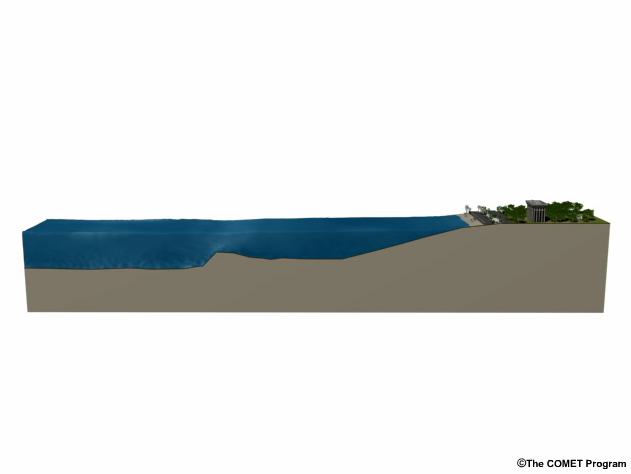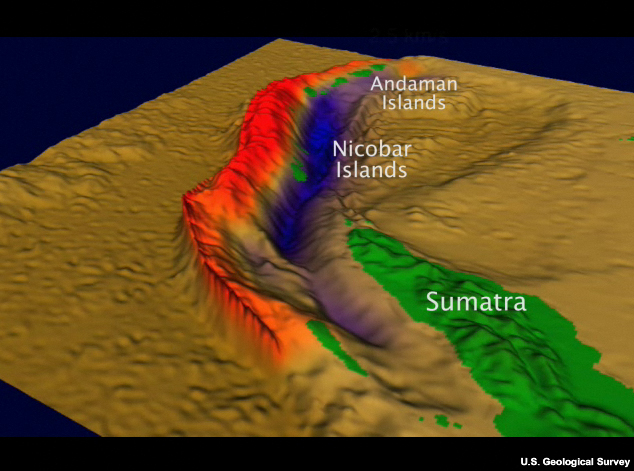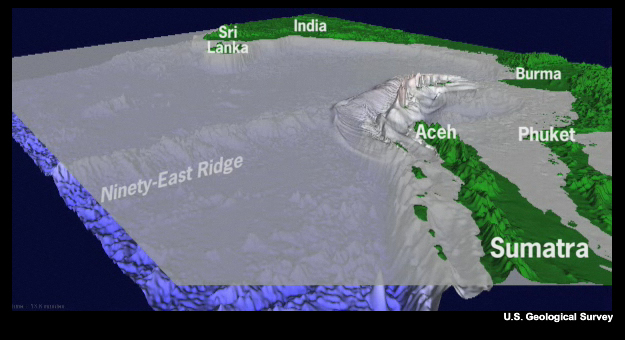Print Version
Initiation
Initiation
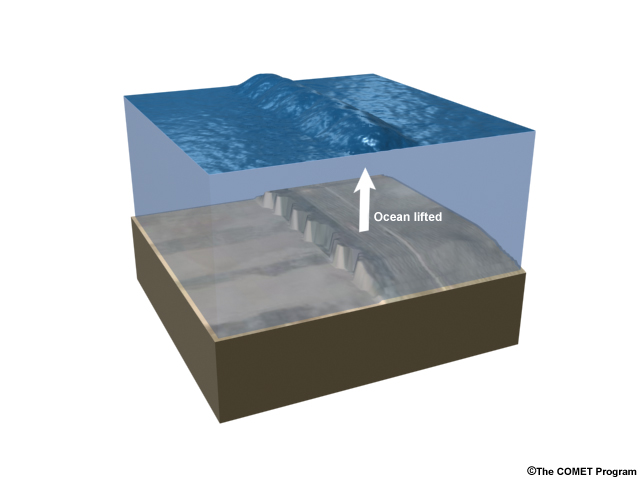
When a large volume of seawater is suddenly displaced, tsunamis result. Let’s look at the mechanics. Thrust faults tend to make the largest earthquake-generated tsunamis.
If the rupture happens quickly—typically within a few seconds for big earthquakes—the water rides up with the seabed and then, propelled by gravity, slides off as expanding waves.
Rock-to-Water Energy Transfer
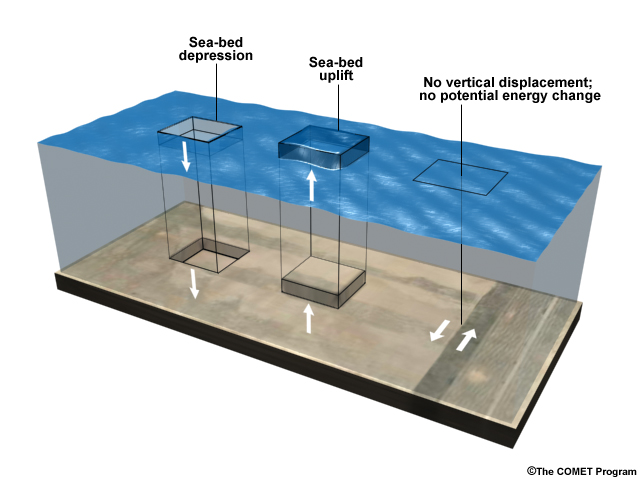
The main mechanism of energy transfer from rock to water is the potential energy change that results from lifting up or dropping down water as the seabed deforms, pushing the sea surface out of equilibrium. Waves form as the displaced water regains equilibrium under gravity's influence. The area and height of the seafloor deformation are the most important factors in how big a tsunami will be.
Vertical Displacement
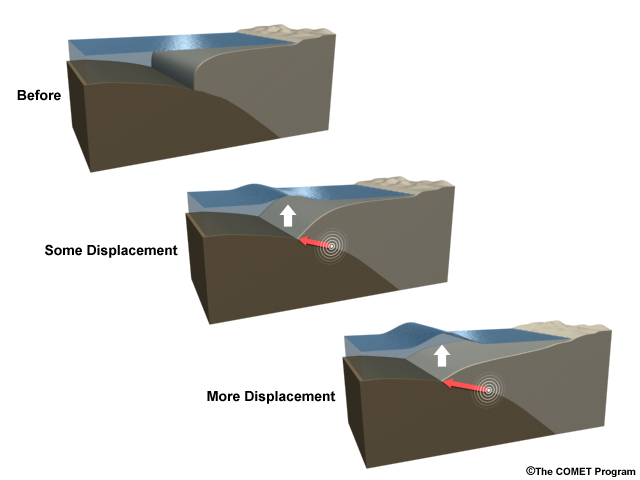
How much the ocean floor rises directly determines the height of resulting waves. In the early stages of wave initiation, the water at the ocean surface copies movement on the ocean bottom, either up or down. The more movement in either direction, the bigger the waves. On the coast, this is usually reflected in the intensity of the shaking. Stronger shaking usually means the earthquake is bigger and closer.
Rupture Length
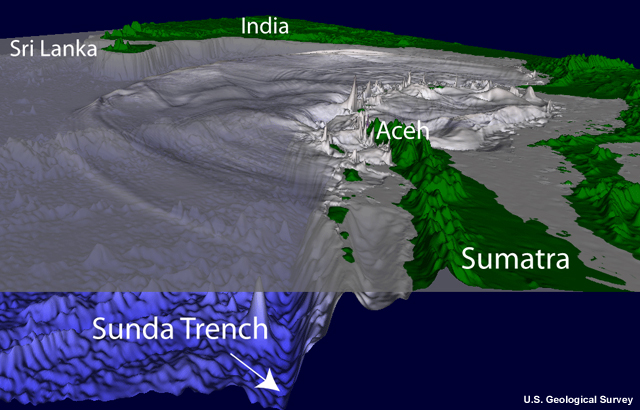
In general, longer ruptures mean more seafloor will be displaced and that any resulting tsunamis will be bigger. Both the 2004 Indian Ocean tsunami and the 1960 Chilean tsunami (produced by the largest earthquake on record) ruptured over 1,000 km (600 mi) of seabed.
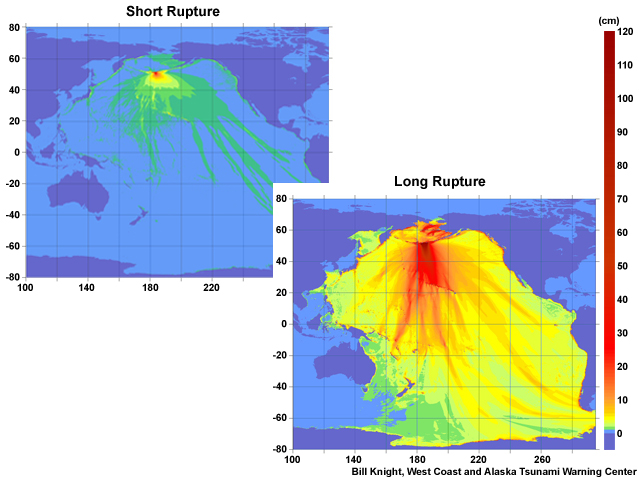
In addition, the longer the rupture, the more directional the propagated tsunami energy. That is, more energy will be focused perpendicular to the fault.
Duration of Quake
What do you think? (Use the selection box to choose the answer that best completes the statement.)
Longer is correct.
The longer an offshore earthquake lasts, the more likely it will produce a strong tsunami. The length of the shaking is related to the length of the rupture; the longer the shaking, the longer the rupture. A magnitude 7 earthquake might rumble for 20-40 seconds. In a magnitude 9 earthquake, the shaking may last 300 seconds—10 times longer.
Water Depth
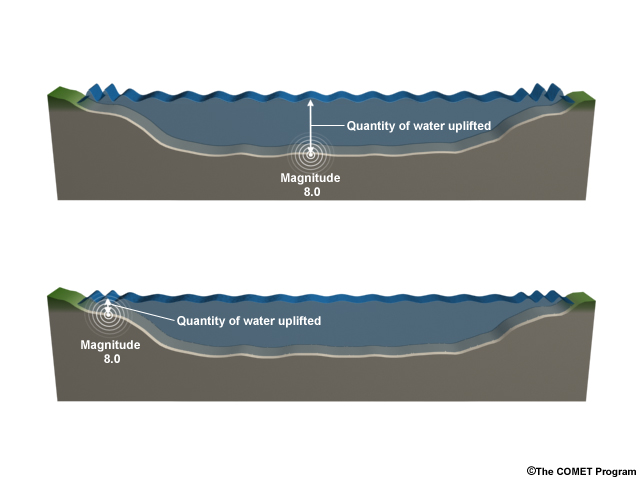
The quantity of water above an earthquake also affects tsunami energy. Think of it this way: the deeper the seabed in which the earthquake occurs, the more water is lifted resulting in greater potential energy. An earthquake in an ocean basin 3 km (2 mi) deep uplifts more water and generates far more potential energy than the same sized earthquake on the continental shelf in water 200 m (660 ft) deep. Thus, a one-meter uplift in the deep ocean will generate a larger tsunami at the shore than a one-meter uplift in shallow water.
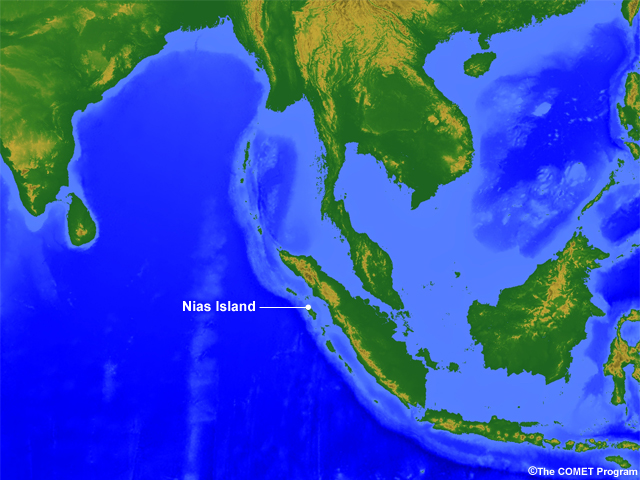
A vivid illustration of this effect is the Nias Island Tsunami in 2005 in the same subduction zone that produced the 2004 Indian Ocean tsunami. Although this was a great earthquake with a magnitude of 8.6, it produced a tsunami that was significant only near the source. The temblor happened in shallow water in a region of barrier islands to the south of the previous quake.
Directionality of Wave Form
What do you think? Tsunamis are always preceded by a retreat of the sea prior to an inundation. (Choose the best answer.)
This is not true. The initial appearance of a tsunami is determined by the wave form created by the water displacement.
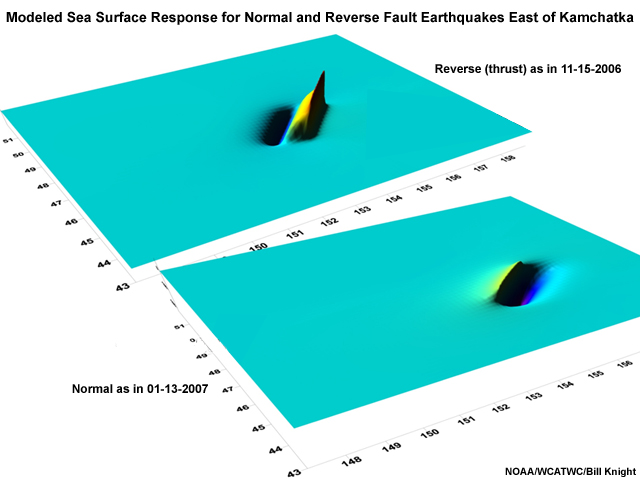
Some tsunamis arrive as a drop in sea level—a classic leading-edge recession where the water is sucked offshore before the first crest arrives. In others, the tsunami arrives as a rapid rise in sea level and flows in without natural warning unless the earthquake was felt first. Whether the sea level rises or falls is determined by which side of a fault a coast lies on. Where the seafloor drops, the water above drops, creating a trough; where the seafloor rises, the water rises as a crest. You can see the effect in this image showing an ideal ocean responding to earthquakes on reverse and normal faults.
Waves approaching a shore from the drop-down side tend to be preceded by a trough, or recession, while those on the uplift side tend to see leading rises. For example, during the Indian Ocean tsunami of 2004, the sea dropped before it surged inland at Sumatra and Thailand, east of the earthquake. In Sri Lanka, on the west side, the sea rose first. Because the island was so far from the earthquake, no shaking warned inhabitants there, either.
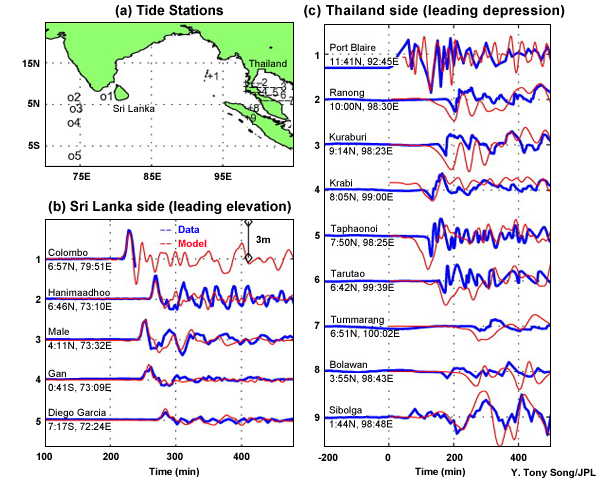
Tide gauge marigrams depicting sea level fluctuations from the Indian Ocean tsunami show the leading edge crest is visible in the Sri Lankan tide gauges, while the leading edge trough is evident on the Thailand side.
Summary Questions
Question 1
What factors can determine the strength of a tsunami? (Choose all that apply.)
The correct answers is A, B, D, and E.
Question 2
Why do tsunamis in deep water tend to make stronger tsunamis? (Choose all that apply.)
The correct answers is A and B.
Question 3
What determines whether the sea initially advances or retreats when a tsunami arrives? (Choose the best answer.)
The correct answer is C. The movement of the seafloor nearest to the coast determines whether wave advancement or retreat is seen first.
Question 4
Tsunamis generated by submarine landslides are not directional and are never preceded by a receding wave. (Choose the best answer.)
False. Submarine landslides tend to move down slope in a definite direction, so the waves they generate can be highly directional, like earthquake-generated tsunamis. In addition, because the seabed slumps downhill, this creates a trough at that location, which can precede the crest at the shore, depending on orientation.
Summary Exercise
Question 1
Suppose two earthquakes struck the same subduction zone just 3 months apart. One earthquake (Earthquake A) displaces about 300,000,000 km2 (100,000 mi2) of seafloor. The other earthquake (Earthquake B) displaces about 50,000 km2 (20,000 mi2).
Based only on this data, which of the two do you think produced the bigger tsunami? (Choose the best answer.)
The correct answer is A.
Question 2
Both earthquakes ruptured the subduction zone 30 km (18 mi) beneath the sea floor.
Based only on this information, which of the two do you think produced the bigger tsunami? (Choose the best answer.)
The correct answer is C.
Question 3
The maximum uplift and subsidence of Earthquake A was 5 m (~16 ft) , while for Earthquake B it was 1 m (~3 ft).
Based only on this information, which of the two do you think produced the bigger tsunami? (Choose the best answer.)
The correct answer is A.
Question 4
The ocean depth in the vicinity of Earthquake A is 500-1000 meters (1640-3280 ft). The ocean depth in the vicinity of Earthquake B is 0-200 meters (0-656 ft) . Based only on this information, which of the two do you think produced the bigger tsunami? (Choose the best answer.)
The correct answer is A.
Question 5
The magnitude of Earthquake A is 9.1. The magnitude of Earthquake B is 8.7. Based only on this information, which tsunami would you expect to be bigger? (Choose the best answer.)
The correct answer is A.
Question 6
There were not many islands in the uplift zone of Earthquake A. There were more islands in the uplift zone of Earthquake B. Based only on this information, which would you expect to produce the bigger tsunami? (Choose the best answer.)
The correct answer is A. Energy that goes into lifting land does nothing to displace water.
Question 7
Here are the two earthquakes' epicenters and approximate rupture zones. Now, thinking about all the information you've been given, which would you expect to generate the bigger tsunami? (Choose the best answer.)
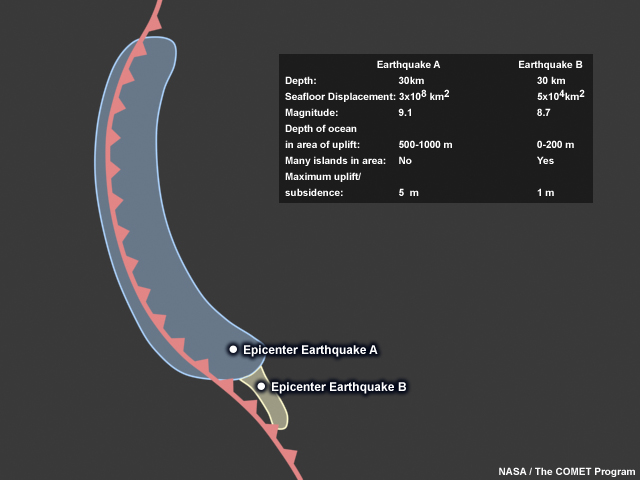
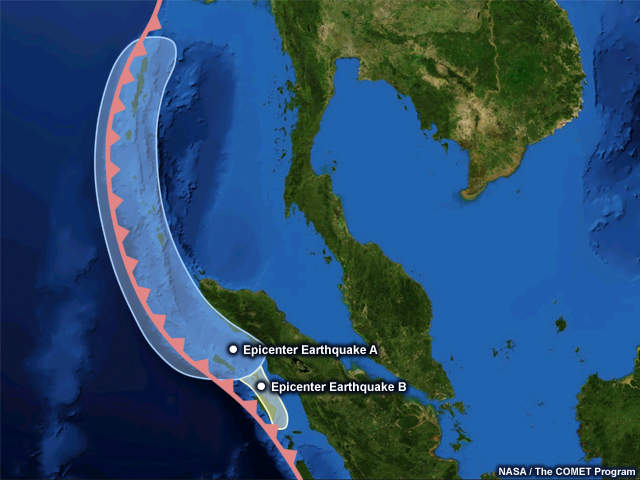
The correct answer is A. In fact, the two tsunamis you've just analyzed were the 2004 Indian Ocean Tsunami (Earthquake A) and the 2005 Nias Island tsunami (Earthquake B). When the tremendous shaking of the 2005 quake was felt, many feared it would generate another massive tsunami. In 2004 the IOT produced runups of 24-30 m. The Nias event, on the other hand, generated waves only 3 m high at most. Thinking back on this exercise, you should now understand why.
